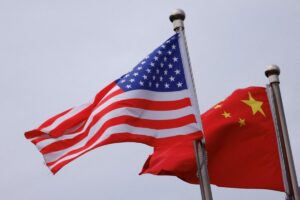
For North American businesses, the “wait and see” period on tariffs is officially over. U.S. President Donald Trump has imposed a 25% levy on goods from Canada and Mexico, along with a 10% tariff on imports from China—a move that could mark the start of a full-scale trade war, sending shockwaves across industries from autos to consumer goods to energy.
The tariffs, part of a declared national emergency to combat the flow of fentanyl and illegal immigration, threaten to destabilize key industries that rely heavily on cross-border supply chains. While many executives had previously dodged questions about potential tariffs, the latest announcement forces companies to confront rising costs head-on.
“All CEOs are bewildered by these non-strategic tariff tantrums being directed at our closest allies instead of adversaries,” said Jeffrey Sonnenfeld, professor at Yale School of Management.
Industries on Edge
Major corporations such as Amazon, Ford Motor, Mondelez International, and Owens-Illinois are set to report earnings this week and will likely face tough questions on how they plan to mitigate the financial blow from these tariffs.
While most companies reached by Reuters declined to comment on the record, industry groups have started to voice concerns. The U.S. Steelworkers union, the largest industrial union in North America, criticized the tariffs, highlighting the $1.3 trillion in trade between the U.S. and Canada.
“These tariffs don’t just hurt Canada. They threaten the stability of industries on both sides of the border,” said union president David McCall.
Supply Chain Disruptions Loom
Industries that depend on intricate international supply chains are particularly vulnerable. Automakers like General Motors and Toyota may shift production back to the U.S., while companies like Alcoa, a global aluminum giant, are exploring ways to reroute shipments to minimize tariff exposure.
“Even if something like a transmission is finally assembled in the United States, it’s sourcing products from all three countries,” said Collin Shaw, president of MEMA Original Equipment Suppliers, which represents over 500 auto suppliers. “A hiccup in just one of those will not only shut down a major component, but you can’t build the rest of the vehicle.”
Consumer Prices Set to Rise
Despite Trump’s claims that tariffs target foreign countries, the costs are paid by importing companies and often passed on to consumers. Retail giants like Walmart and Target, which have been battling inflation to keep prices low, may now struggle to absorb the higher supply chain expenses.
“As long as these universal tariffs are in place, Americans will be forced to pay higher prices on everyday consumer goods,” said David French, executive vice president of government relations at the National Retail Federation.
Meanwhile, Church & Dwight, the maker of Arm & Hammer detergent and Trojan condoms, announced plans to focus on local manufacturing and productivity improvements to cushion the impact.
“These are volatile situations, so we’ll see how long it lasts and what happens,” CFO Rick Dierker said during an earnings call on Friday. “We have the ability to be reactive when we need to be.”
Economic Fallout and Stagflation Risks
Economists warn that the tariffs could have far-reaching consequences. A model from EY Chief Economist Greg Daco suggests the tariffs could reduce U.S. economic growth by 1.5 percentage points in 2025, potentially plunging Canada and Mexico into recession and triggering stagflation—a mix of stagnant economic growth and rising inflation—within the U.S.
“Steep tariff increases against U.S. trading partners could create a stagflationary shock — a negative economic hit combined with an inflationary impulse — while also triggering financial market volatility,” Daco wrote.
The market has already started to react. The Mexican peso and Canadian dollar slumped following Trump’s announcement, while U.S. stock prices fell, and Treasury bond yields rose, signaling investor anxiety over the economic outlook.
Uncertain Future
Trump has defended the tariffs as a strategy to bring manufacturing back to the U.S., though this approach has frustrated companies that previously relocated operations from China to Canada and Mexico during his first term, only to face new tariffs after “nearshoring” closer to home.
While the long-term effects of the tariffs remain to be seen, companies across North America are now scrambling to adjust to a rapidly shifting trade landscape.





















Comments are closed for this article!